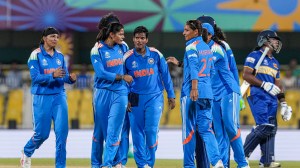Sunday Long Reads: Kerala’s Lokame Tharavadu, Rashtrapati Bhavan’s musical history, Rakeysh Omprakash Mehra interview, and more
Check out this week's Sunday Eye stories
 Artists’ collective Trespassers working on a mural. (Swanoop John/Kochi Biennale Foundation)
Artists’ collective Trespassers working on a mural. (Swanoop John/Kochi Biennale Foundation)Why Kerala’s Lokame Tharavadu, showing over 250 Malayali artists, was a need of the hour
One of the oldest planned towns of Kerala, the picturesque port city of Alappuzha sits between the vast Arabian Sea and the placid Vembanad Lake. Designed by Raja Kesavadas, the dewan of Travancore during the reign of Dharma Raja Karthika Thirunal Rama Varma, traders flocked its shores for spices and coir in the 1800s. Its fortunes were to shine brighter after Irish-American merchant James Darragh set up India’s first coir factory in 1859 in Alappuzha. The establishment of Darragh Smail & Company propelled further investment, making it the famed land of golden fibre, though its significance as a trading hub dwindled over the years.
Why a Western critic’s outdated views on Indian food captures nothing of its versatility
 The range of Indian food, its flavours, styles and tastes, across the country’s length and breadth, is a mystery to those not knowledgeable about it (Illustration: Suvir Saran)
The range of Indian food, its flavours, styles and tastes, across the country’s length and breadth, is a mystery to those not knowledgeable about it (Illustration: Suvir Saran)
Reading what Gene Weingarten wrote so casually and confidently about Indian food wasn’t as appalling to me as finding his words in a newspaper of The Washington Post’s character and reputation. In an article dated August 19, he wrote, “If you think Indian curries taste like something that could knock a vulture off a meat wagon, you do not like a lot of Indian food. I don’t get it, as a culinary principle.” But I suppose newspapers must print such things; otherwise, they wouldn’t be telling us what’s going on in the minds and hearts of people. So as sad and unfortunate as it is that Weingarten’s screed was given space in The Washington Post, it’s almost a blessing. Now the onus is upon those of us who know better to react.
In the Shadow of Freedom: Postcard from Chauri Chaura
 Chauri Chaura railway station (Photo: Vishal Srivastav)
Chauri Chaura railway station (Photo: Vishal Srivastav)
Nearly a century ago, a little-known place in the far-off eastern corner of the United Provinces, Chauri Chaura (now a tehsil in Uttar Pradesh’s Gorakhpur district), changed the course of India’s freedom struggle. A mass demonstration had led the police to open fire. In retaliation, the police station was set ablaze, killing 23 policemen. Condemning the incident, Mahatma Gandhi withdrew his Non-Cooperation Movement to reinforce the principle of non-violence. This year, as the country moves towards its 75th year of Independence, the government launched the Chauri Chaura centenary celebrations with an upgraded Shaheed Smarak. For the locals, however, especially the fourth generation of freedom fighters, the struggle continues – to get jobs, better roads, and a proper drainage system.
Part II: How Mother Nature’s air-to-air hunters keep pest numbers down
 A young wire-tailed swallow stretches its wings. (Source: Ranjit Lal)
A young wire-tailed swallow stretches its wings. (Source: Ranjit Lal)
Raptors take down their kills one at a time. But the fastback fighters, part of Mother Nature’s Air Force (MNAF) we’ll meet now, go wholesale to keep pest numbers down. We’ll meet three specialists: the swifts, swallows and secretive mottled nightjars. All three go in for insects on the wing, have niche hunting blocks and different attack hours. Sensibly, all three avoid the stingers: bees and wasps. They have narrow swept-back wings, and deeply-forked tails, designed for high speeds and astonishing maneuverability. They have especially wide gapes and unlike the raptors, their kill weapon is their bill — not their feet, which, in fact, are weak and flimsy.
Shankar’s Fairies shows how class determines your life and choices
 A still from Irfana Majumdar’s debut Hindi feature.
A still from Irfana Majumdar’s debut Hindi feature.
Do you believe in fairies? Well, you might say, it depends. Upon how old you are. How credulous you are. Or if you are an adult who’s never lost sight of the child you used to be.
Irfana Majumdar’s lovely, emotive debut feature Shankar’s Fairies takes you back to a time when fairies, and other mysterious creatures like chudails (witches), were part of your imaginative inner life, fed by a grown-up who told you those stories with great zest.
When Rang De Basanti brought the youth out on the streets
 For his sophomore, Rang De Basanti (RDB, 2006), he wanted to turn the local sociopolitical context into world cinema, juxtaposing the past (freedom fighters Bhagat Singh, Shivaram Rajguru, Chandrashekhar Azad, Ashfaqulla Khan, Ram Prasad Bismil) with the contemporary. (Express Archive)
For his sophomore, Rang De Basanti (RDB, 2006), he wanted to turn the local sociopolitical context into world cinema, juxtaposing the past (freedom fighters Bhagat Singh, Shivaram Rajguru, Chandrashekhar Azad, Ashfaqulla Khan, Ram Prasad Bismil) with the contemporary. (Express Archive)
When Arun Jaitley, then I&B minister, met Bombay filmmakers to discuss “censorship”, filmmaker Rakeysh Omprakash Mehra recalls having said, “take the scissors, throw it in the ocean.” “You need certification, not censorship. Mr Jaitley formed a committee (Benegal Committee, 2016) with chairman Shyam babu (Benegal), Kamal Haasan, Goutam Ghose, myself…we spent a year on it, spoke to all stakeholders, there was enough experience and representation in the room. We framed a law, he (the late Jaitley) liked it, but it never saw the light of day. The ministry changed and he (Jaitley) was made the defence minister,” says Mehra, 58, his long hair and beard freshly trimmed.
From jazz to Indian classical, how music plays a key part at the Rashtrapati Bhavan
 Former president Dr APJ Abdul Kalam playing the Saraswati veena at Rashtrapati Bhavan
Former president Dr APJ Abdul Kalam playing the Saraswati veena at Rashtrapati Bhavan
President Bill Clinton was in for a pleasant surprise during the banquet held in his honour at the Rashtrapati Bhavan during his March 2000 visit. He might not have expected to hear jazz at the ceremonial function, but the president’s Naval Jazz Band played it, and played it so well that Clinton, an accomplished saxophonist himself, went to meet the musicians. He is said to have especially appreciated the saxophone player.



- 01
- 02
- 03
- 04
- 05



























